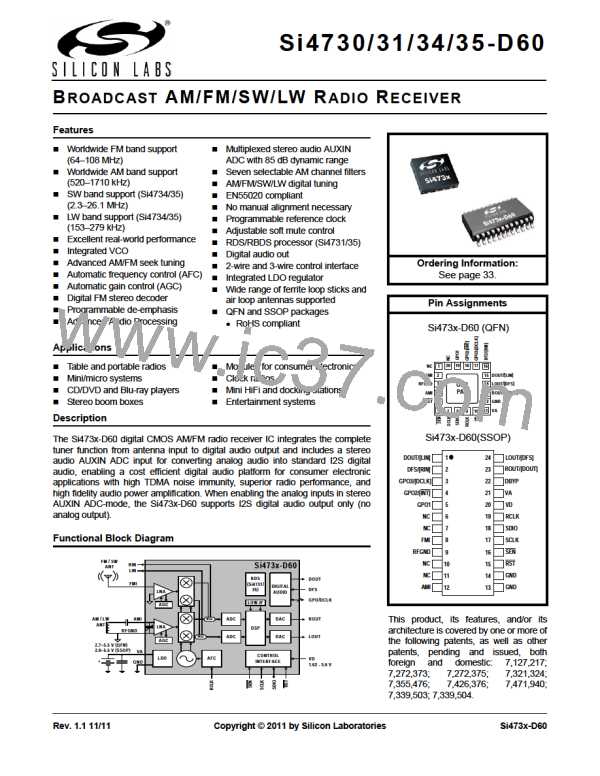Si4730/31/34/35-D60
4.9. Stereo Audio Processing
4.10. Received Signal Qualifiers
The output of the FM demodulator is a stereo The quality of a tuned signal can vary depending on
multiplexed (MPX) signal. The MPX standard was many factors including environmental conditions, time of
developed in 1961, and is used worldwide. Today's day, and position of the antenna. To adequately manage
MPX signal format consists of left + right (L+R) audio, the audio output and avoid unpleasant audible effects to
left – right (L–R) audio, a 19 kHz pilot tone, and the end-user, the Si473x-D60 monitors and provides
RDS/RBDS data as shown in Figure 11 below.
indicators of the signal quality, allowing the host
processor to perform additional processing if required
by the customer. The Si473x-D60 monitors signal
quality metrics including RSSI, SNR, and multipath
interference on FM signals. These metrics are used to
optimize signal processing and are also reported to the
host processor. The signal processing algorithms can
Mono Audio
Left + Right
Stereo
Pilot
Stereo Audio
Left - Right
RDS/
RBDS
use
either
Silicon
Labs'
optimized
settings
(recommended) or be customized to modify
performance.
0
15 19 23
38
53 57
Frequency (kHz)
4.11. Volume Control
Figure 11. MPX Signal Spectrum
The audio output may be muted. Volume is adjusted
digitally by the RX_VOLUME property.
4.9.1. Stereo Decoder
The Si473x-D60's
integrated
stereo
decoder
4.12. Stereo DAC
automatically decodes the MPX signal using DSP
techniques. The 0 to 15 kHz (L+R) signal is the mono
output of the FM tuner. Stereo is generated from the
(L+R), (L–R), and a 19 kHz pilot tone. The pilot tone is
used as a reference to recover the (L–R) signal. Output
left and right channels are obtained by adding and
subtracting the (L+R) and (L–R) signals respectively.
High-fidelity stereo digital-to-analog converters (DACs)
drive analog audio signals onto the LOUT and ROUT
pins. The audio output may be muted.
4.13. Soft Mute
The soft mute feature is available to attenuate the audio
outputs and minimize audible noise in very weak signal
conditions. The soft mute feature is triggered by the
SNR metric. The SNR threshold for activating soft mute
is programmable, as are soft mute attenuation levels
and attack and release rates.
4.9.2. Stereo-Mono Blending
Adaptive noise suppression is employed to gradually
combine the stereo left and right audio channels to a
mono (L+R) audio signal as the signal quality degrades
to maintain optimum sound fidelity under varying
reception conditions. Three metrics, received signal
strength indicator (RSSI), signal-to-noise ratio (SNR),
4.14. FM Hi-Cut Control
Hi-cut control is employed on audio outputs with
degradation of the signal due to low SNR and/or
multipath interference. Two metrics, SNR and multipath
interference, are monitored concurrently in forcing hi-cut
of the audio outputs. Programmable minimum and
maximum thresholds are available for both metrics. The
transition frequency for hi-cut is also programmable with
up to seven hi-cut filter settings. A single set of attack
and release rates for hi-cut are programmable for both
metrics from a range of 2 ms to 64 s. The level of hi-cut
applied can be monitored with the FM_RSQ_STATUS
command. Hi-cut can be disabled by setting the hi-cut
filter to audio bandwidth of 15 kHz.
and
multipath
interference,
are
monitored
simultaneously in forcing a blend from stereo to mono.
The metric which reflects the minimum signal quality
takes precedence and the signal is blended
appropriately.
All three metrics have programmable stereo/mono
thresholds and attack/release rates. If a metric falls
below its mono threshold, the signal is blended from
stereo to full mono. If all metrics are above their
respective stereo thresholds, then no action is taken to
blend the signal. If a metric falls between its mono and
stereo thresholds, then the signal is blended to the level
proportional to the metric’s value between its mono and
stereo thresholds, with an associated attack and
release rate.
Rev. 1.1
27
